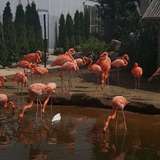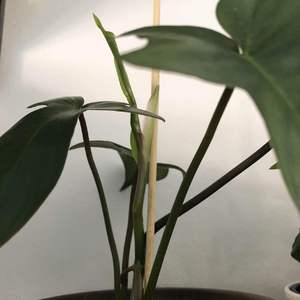求助
kensong
2018年05月31日

Okay, this is my first Phalenopsis (moth orchid). This is about 2 weeks after I cut off its flower stalks after they dropped. Then I repotted. Is this a new leaf I see? Why is it brown red?


0
0
Fion:Because this is new leaf, not all new leaves of plants are tender green.
sunnyzou:do not worry. New leaves are usually like this.
求助
kensong
2018年05月30日

Does anyone know if Ficus Lyrata (Fiddle Leaf Fig) can be propogated using leaf cuttings?
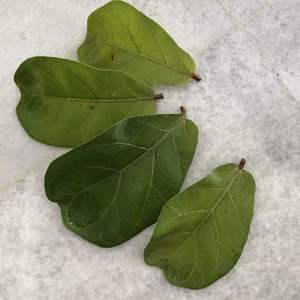

1
0
suculea:The leaf will root, but you won't get a new growth. only leaf woth roots
sunnyzou:Wow, you could try
kensong:@sunnyzou this root from a leaf. I also thought it was not possible.
sunnyzou:I don’t think so
成长记
Plantlin
2018年05月28日

Some updates. new big leaf is coming out, but it seems green again! Okok, I’ll try to be patient till it unfolds:) on the one stem part, I think there is a geowingpoint visible! I almost threw that out!!! So happy:) And even more patience;) 💚

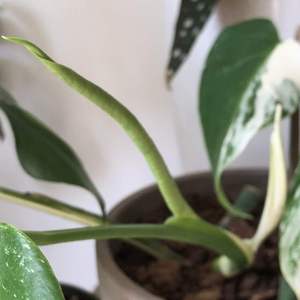










0
0
文章
Miss Chen
2018年05月24日

Description: This perennial wildflower is 2-3' tall and usually unbranched. The central stem is light green, terete or angular, and glabrous to hairy; it has a tendency to zigzag between the alternate leaves. The leaf blades are 2-5" long and 1-4" across, becoming shorter and more narrow where the flowers occur; they areFlowering Plant widely spreading. The lower to middle leaves are ovate to broadly ovate, while the upper leaves are more lanceolate. The leaf margins are coarsely serrated. The upper surfaces of the leaves are medium to dark green and glabrous, while their lowers surfaces are more pale and glabrous to slightly hairy. The petioles are ¼–1½" long and somewhat winged near the bases of the leaf blades. At the apex of the central stem, there is a terminal inflorescence about 1½–5" long and about one-third as much across. This inflorescence is either a raceme or narrow panicle of flowerheads. There are also smaller axillary racemes about ½–1½" long that develop from the middle to upper leaves; they are shorter than the leaves. The branches of each inflorescence are light green and glabrous. Each flowerhead is about ¼" across or a little less, consisting of 3-4 yellow ray florets, 4-8 yellow disk florets, and several series of floral bracts at its base. The floral bracts are light green and appressed. The blooming period occurs from late summer to early fall and lasts about 1 month. Both ray and disk florets are fertile. During the fall, the florets are replaced by achenes with small tufts of hair; they are distributed by the wind. The small achenes are bullet-shaped and pubescent. The root system is fibrous and rhizomatous. Vegetative colonies of plants are sometimes formed from the spreading rhizomes.
Cultivation: The preference is light to medium shade, moist to dry-mesic conditions in sheltered situations, and fertile loamy soil with decaying organic matter. This is one of the most shade-tolerant goldenrods.
Range & Habitat: The native Zigzag Goldenrod is occasional in central and northern Illinois, becoming uncommon or absent in the southern section of the state (see Distribution Map). Habitats include rich deciduous woodlands, protected wooded slopes facing north or east, calcareous seeps in wooded areas, low areas along woodland streams, shaded limestone cliffs, and edges of limestone glades. This wildflower is usually found in higher quality natural areas.
Faunal Associations: The flowerheads are pollinated by many kinds of insects, including long-tongued bees, small-tongued bees, wasps, flies, and butterflies. Several bees are oligoleges of Solidago spp. (Goldenrods). These species include: Andrena hirticincta, Andrena nubecula, Andrena placata, Andrena simplex, Andrena solidaginis, and Colletes simulans armata. Many insects feed on the leaves, flowers, seeds, and roots of goldenrods. These insect feeders include plant bugs, stink bugs, aphids, leaf beetles, and the caterpillars of many moths (see the Moth Table and the Insect Table for a listing of these species). These insects are a source of food to many woodland songbirds and some upland gamebirds. White-tailed Deer readily browse on the foliage of Zigzag Goldenrod.

Photographic Location: A wooded slope at Turkey Run State Park in west-central Indiana.
Comments: Zigzag Goldenrod is a member of a small group of woodland goldenrods (Solidago spp.); other species in this group include Solidago caesia (Bluestem Goldenrod) and Solidago ulmifolia (Elm-Leaved Goldenrod). Zigzag Goldenrod often occurs more moist habitats than the latter two goldenrods, but it also occurs in drier areas of woodlands that are sheltered from the prevailing winds and afternoon sunlight. Because of its broad coarsely toothed leaves and axillary racemes of flowerheads, it is one of the easiest goldenrods to identify. Another common name of this species is Broad-Leaved Goldenrod.
Cultivation: The preference is light to medium shade, moist to dry-mesic conditions in sheltered situations, and fertile loamy soil with decaying organic matter. This is one of the most shade-tolerant goldenrods.
Range & Habitat: The native Zigzag Goldenrod is occasional in central and northern Illinois, becoming uncommon or absent in the southern section of the state (see Distribution Map). Habitats include rich deciduous woodlands, protected wooded slopes facing north or east, calcareous seeps in wooded areas, low areas along woodland streams, shaded limestone cliffs, and edges of limestone glades. This wildflower is usually found in higher quality natural areas.
Faunal Associations: The flowerheads are pollinated by many kinds of insects, including long-tongued bees, small-tongued bees, wasps, flies, and butterflies. Several bees are oligoleges of Solidago spp. (Goldenrods). These species include: Andrena hirticincta, Andrena nubecula, Andrena placata, Andrena simplex, Andrena solidaginis, and Colletes simulans armata. Many insects feed on the leaves, flowers, seeds, and roots of goldenrods. These insect feeders include plant bugs, stink bugs, aphids, leaf beetles, and the caterpillars of many moths (see the Moth Table and the Insect Table for a listing of these species). These insects are a source of food to many woodland songbirds and some upland gamebirds. White-tailed Deer readily browse on the foliage of Zigzag Goldenrod.

Photographic Location: A wooded slope at Turkey Run State Park in west-central Indiana.
Comments: Zigzag Goldenrod is a member of a small group of woodland goldenrods (Solidago spp.); other species in this group include Solidago caesia (Bluestem Goldenrod) and Solidago ulmifolia (Elm-Leaved Goldenrod). Zigzag Goldenrod often occurs more moist habitats than the latter two goldenrods, but it also occurs in drier areas of woodlands that are sheltered from the prevailing winds and afternoon sunlight. Because of its broad coarsely toothed leaves and axillary racemes of flowerheads, it is one of the easiest goldenrods to identify. Another common name of this species is Broad-Leaved Goldenrod.
0
0
文章
Miss Chen
2018年05月21日

Description: This herbaceous perennial plant is 1–1½' tall. Infertile plants are unbranched, producing a single leaf from a long stalk, while fertile plants produce a pair of leaves on long petioles at the apex of this stalk. The stalks are light green to pale reddish green, glabrous, and terete (circular in circumference). The leaves of infertile plants are up to 1' long and 1' across; they are orbicular in outline, fully peltate, and deeply divided in 6-9 palmate lobes. The leaves of fertile plants are similar, although they are less orbicular in outline, only marginally peltate, and they tend to have fewer lobes (typically 5-6). The leaves of both infertile and fertile plants have lobes that are obovate in shape. The outer margins of these lobes are coarsely dentate and often shallowly cleft; less typically, they are coarsely crenate, slightly undulate, or smooth (entire). The upper leaf surface is medium to dark green and glabrous. On fertile plants, the ascending petioles of the leaves are 3-6" long, light green to pale reddish green, glabrous, and terete. The petioles join the leaf blades toward the inner margins of the latter. Each fertile plant produces a single nodding flower where the 2 petioles branch from each other.
This flower is about 1½" across, consisting of 6-9 white petals, 6 light green sepals, 12-18 stamens, and a superior ovary with a dome-shaped cluster of stigmata at its apex. Both the petals and sepals are oval-obovate in shape; the latter are glabrous and early-deciduous. The ovary is ovoid in shape and light green to pale yellow. The stamens have white filaments and yellow anthers. The pedicel of the flower is about 1½" long, light green to yellowish green, and glabrous. The blooming period occurs from mid- to late spring, lasting about 2-3 weeks. Individual flowers are short-lived; they have a pleasant fragrance. Each flower is replaced by an ovoid berry that is fleshy and contains several seeds. At maturity, this berry is about 1½" long and pale yellow. A berry is produced only when cross-pollination of the flower occurs. The root system is long-rhizomatous and fibrous. Mayapple often produces dense colonial colonies that exclude other spring-flowering plants.
Cultivation: The preference is dappled sunlight to light shade, moist to slightly dry conditions, and a rich loamy soil with abundant organic matter. This plant is easy to start from rhizomes and it will readily adapt to garden areas near deciduous trees. It is a strong colonizer and may spread aggressively in some situations. Young foliage is vulnerable to late-frost damage. The mature foliage dies down by the end of summer.

Range & Habitat: The native Mayapple is a common plant that occurs in every county of Illinois (see Distribution Map). It is found primarily in mesic deciduous woodlands, open woodlands, small woodland openings, savannas, and edges of hillside seeps in wooded areas. Mayapple occurs in high quality old-growth woodlands and also open woodlands that have some history of disturbance.
Faunal Associations: The flowers are cross-pollinated by bumblebees and other long-tongued bees. These insects collect pollen and possibly suck nectar. The larvae of a sawfly, Aglaostigma quattuordecimpunctatum, feed on the leaves of Mayapple (Smith, 2006). Adults of a thrips, Ctenothrips bridwelli, have been found on the foliage (Stannard, 1968). The foliage of Mayapple is avoided by mammalian herbivores because of its poisonous qualities and bitter taste. The seeds and rhizomes are also poisonous. The berries are edible if they are fully ripe; they are eaten by box turtles and possibly by such mammals as opossums, raccoons, and skunks. The seeds are distributed to new locations in the feces of these animals.

Photographic Location: A mesic deciduous woodland at Busey Woods in Urbana, Illinois.
Comments: Mayapple is a familiar woodland plant with interesting foliage. The flowers are large and attractive, but they are sparingly produced and mostly hidden by the large leaves. Mayapple develops very quickly during the warmer days of spring. There is no other plant within the state that resembles it; the only other species in this genus occurs in Asia. People can eat the ripe berries in limited amounts, even though they may be mildly toxic. The flavor is bland and resembles an overripe melon.
This flower is about 1½" across, consisting of 6-9 white petals, 6 light green sepals, 12-18 stamens, and a superior ovary with a dome-shaped cluster of stigmata at its apex. Both the petals and sepals are oval-obovate in shape; the latter are glabrous and early-deciduous. The ovary is ovoid in shape and light green to pale yellow. The stamens have white filaments and yellow anthers. The pedicel of the flower is about 1½" long, light green to yellowish green, and glabrous. The blooming period occurs from mid- to late spring, lasting about 2-3 weeks. Individual flowers are short-lived; they have a pleasant fragrance. Each flower is replaced by an ovoid berry that is fleshy and contains several seeds. At maturity, this berry is about 1½" long and pale yellow. A berry is produced only when cross-pollination of the flower occurs. The root system is long-rhizomatous and fibrous. Mayapple often produces dense colonial colonies that exclude other spring-flowering plants.
Cultivation: The preference is dappled sunlight to light shade, moist to slightly dry conditions, and a rich loamy soil with abundant organic matter. This plant is easy to start from rhizomes and it will readily adapt to garden areas near deciduous trees. It is a strong colonizer and may spread aggressively in some situations. Young foliage is vulnerable to late-frost damage. The mature foliage dies down by the end of summer.

Range & Habitat: The native Mayapple is a common plant that occurs in every county of Illinois (see Distribution Map). It is found primarily in mesic deciduous woodlands, open woodlands, small woodland openings, savannas, and edges of hillside seeps in wooded areas. Mayapple occurs in high quality old-growth woodlands and also open woodlands that have some history of disturbance.
Faunal Associations: The flowers are cross-pollinated by bumblebees and other long-tongued bees. These insects collect pollen and possibly suck nectar. The larvae of a sawfly, Aglaostigma quattuordecimpunctatum, feed on the leaves of Mayapple (Smith, 2006). Adults of a thrips, Ctenothrips bridwelli, have been found on the foliage (Stannard, 1968). The foliage of Mayapple is avoided by mammalian herbivores because of its poisonous qualities and bitter taste. The seeds and rhizomes are also poisonous. The berries are edible if they are fully ripe; they are eaten by box turtles and possibly by such mammals as opossums, raccoons, and skunks. The seeds are distributed to new locations in the feces of these animals.

Photographic Location: A mesic deciduous woodland at Busey Woods in Urbana, Illinois.
Comments: Mayapple is a familiar woodland plant with interesting foliage. The flowers are large and attractive, but they are sparingly produced and mostly hidden by the large leaves. Mayapple develops very quickly during the warmer days of spring. There is no other plant within the state that resembles it; the only other species in this genus occurs in Asia. People can eat the ripe berries in limited amounts, even though they may be mildly toxic. The flavor is bland and resembles an overripe melon.
0
0
成长记
Plantlin
2018年05月21日

And the second leaf I put in soil for cuttings and seeds! Only added some water to the first three pieces. Let’s wait and see! Owww can’t wait! ;)
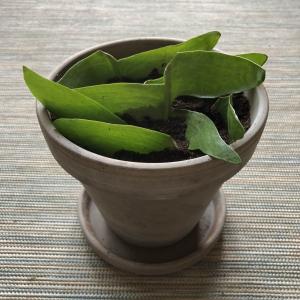
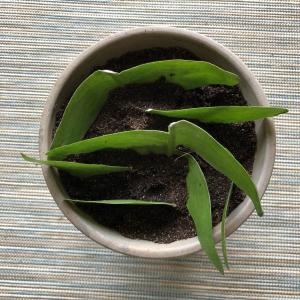


1
0
成长记
lgorley
2018年05月20日

I now added "Vertical Leaf Senecio- Senecio crassissimus" in my "garden"
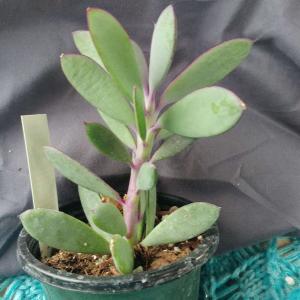

1
0
文章
Miss Chen
2018年05月20日

Description: This perennial wildflower is about 1-2' tall and similarly across. It has a single erect stem that is hairless and unbranched; the stem terminates in a whorl of about 3 compound leaves. Each compound leaf is palmate with 5 widely spreading leaflets; the petiole (basal stalk) of each compound leaf is 2-5" long. Individual leaflets are 2½–6" long and ¾–2½" across; they are ovate to obovate, medium green, hairless, and finely serrated along their margins. The lower pair of leaflets are smaller in size than the other leaflets. The larger leaflets have longer petiolules (basal stalklets) than the smaller leaflets, and they have short slender tips.
From the terminal point of the central stem, there develops a single umbel of greenish white flowers. There are about 10-20 flowers per umbel; each umbel is about ½–¾" across. Individual flowers are only 1/8" (3 mm.) across; each flower has 5 spreading petals, a short tubular calyx, 5 stamens, and a pistil. The calyx has 5 tiny teeth. The blooming period occurs from early to mid-summer and lasts about 2 weeks. During the fall, fertile flowers are replaced by a small cluster of bright red berries spanning about ¾" across. Each berry is globoid-ovoid in shape and contains about 2 seeds. The root system consists of a fleshy taproot that is fusiform in shape (widest in the middle and tapering at both ends); this taproot can be several inches long. American Ginseng reproduces by reseeding itself.
Cultivation: The preference is medium to light shade, a rich loamy soil with abundant organic material, and mesic conditions.
Range & Habitat: The native American Ginseng is distributed throughout Illinois, but it is relatively uncommon. Populations have declined because of habitat destruction and overcollection of the fleshy roots. This wildflower is found mesic deciduous woodlands. Usually, such woodlands are high quality and little-disturbed.
Faunal Associations: Very little is known about floral-faunal relationships for this species. Probably small bees and various flies visit the flowers for nectar or pollen. The red berries are probably eaten to a limited extent by woodland birds that either nest or search for food on the ground; small rodents may eat the berries as well.
Photographic Location: Spitzler Woods Nature Preserve in Macon County, Illinois. This preserve contains a high quality deciduous woodland. The photograph was taken during the autumn, when the berries become mature.
Comments: It is unfortunate that this classic woodland wildflower has become uncommon. American Ginseng is a member of a small group of plants in the Araliaceae; these consist primarily of woodland wildflowers in Illinois. Another woodland wildflower that does not occur within the state, Panax trifolius (Dwarf Ginseng), is found further to the east. Dwarf Ginseng is smaller in size (about 6" tall) than American Ginseng, and its compound leaves are trifoliate, rather than palmate with 5 leaflets. The flowers and berries of these two species are similar to each other.
From the terminal point of the central stem, there develops a single umbel of greenish white flowers. There are about 10-20 flowers per umbel; each umbel is about ½–¾" across. Individual flowers are only 1/8" (3 mm.) across; each flower has 5 spreading petals, a short tubular calyx, 5 stamens, and a pistil. The calyx has 5 tiny teeth. The blooming period occurs from early to mid-summer and lasts about 2 weeks. During the fall, fertile flowers are replaced by a small cluster of bright red berries spanning about ¾" across. Each berry is globoid-ovoid in shape and contains about 2 seeds. The root system consists of a fleshy taproot that is fusiform in shape (widest in the middle and tapering at both ends); this taproot can be several inches long. American Ginseng reproduces by reseeding itself.
Cultivation: The preference is medium to light shade, a rich loamy soil with abundant organic material, and mesic conditions.
Range & Habitat: The native American Ginseng is distributed throughout Illinois, but it is relatively uncommon. Populations have declined because of habitat destruction and overcollection of the fleshy roots. This wildflower is found mesic deciduous woodlands. Usually, such woodlands are high quality and little-disturbed.
Faunal Associations: Very little is known about floral-faunal relationships for this species. Probably small bees and various flies visit the flowers for nectar or pollen. The red berries are probably eaten to a limited extent by woodland birds that either nest or search for food on the ground; small rodents may eat the berries as well.
Photographic Location: Spitzler Woods Nature Preserve in Macon County, Illinois. This preserve contains a high quality deciduous woodland. The photograph was taken during the autumn, when the berries become mature.
Comments: It is unfortunate that this classic woodland wildflower has become uncommon. American Ginseng is a member of a small group of plants in the Araliaceae; these consist primarily of woodland wildflowers in Illinois. Another woodland wildflower that does not occur within the state, Panax trifolius (Dwarf Ginseng), is found further to the east. Dwarf Ginseng is smaller in size (about 6" tall) than American Ginseng, and its compound leaves are trifoliate, rather than palmate with 5 leaflets. The flowers and berries of these two species are similar to each other.
0
0
文章
Miss Chen
2018年05月17日

Description: This herbaceous perennial wildflower is 3-8" tall. An infertile shoot usually consists of a single basal leaf, while a fertile shoot consists of a flowering stalk with 2 alternate leaves (less often, there are 3 leaves). Both basal and alternate leaves are similar in appearance, although the former have petioles up to 2" long. The leaves are up to 3" long and 2" across, smooth (entire) along their margins, and ovate-oblong to oval in shape. Leaf venation is parallel. The upper leaf surface is medium green and glabrous, while the lower leaf surface is pale green and finely pubescent. Unlike var. interius, the typical variety of Canada Mayflower has leaves without hairs. The base of each alternate leaf is clasping, sessile, or short-petioled. The central stalk is light to medium green, terete, and glabrous or hairy. At the apex of each flowering stalk, there is a short-cylindrical raceme of flowers about 1-2" long.
The flowers typically occur in pairs along the raceme on slender pedicels. Individual flowers have 4 white tepals, 4 stamens with white filaments and pale yellow anthers, and a white to greenish white pistil with a pair of knobby stigmata. The tepals are lanceolate and strongly recurved, fully exposing the reproductive organs. Each flower is a little less than ¼" (6 mm.) across. The blooming period occurs from late spring to early summer. The flowers are fragrant. During the summer, fertile flowers are replaced by globoid berries that are individually a little less than ¼" (6 mm.) across. At maturity, these berries are speckled pale red, and each berry typically contains 2 seeds. The root system is rhizomatous and fibrous. Vegetative colonies are often formed via the rhizomes. In a typical colony, infertile shoots usually outnumber flowering fertile shoots.

Cultivation: The preference is dappled sunlight to moderate shade, moist to slightly dry conditions, high humidity, and cool temperatures. This wildflower adapts to an acidic soil containing peat, sand, or rocky material (e.g., sandstone). It doesn't tolerate much competition from taller plants.
Range & Habitat: The native Canada Mayflower is uncommon in Illinois; it is restricted to the northern section of the state (see Distribution Map). Illinois lies at the southern range limit of this largely boreal species; it is more common further to the north in the Great Lakes region and further to the northeast in New England. The western variety of Canada Mayflower, var. interius, is far more common within the state than the more eastern typical variety. Habitats include sandy meadows, sandy thickets, sandy woodlands, north-facing wooded slopes, shaded bogs, and sandstone ledges along ravines in wooded areas. In Illinois, Canada Mayflower is associated with high quality natural areas.

Faunal Associations: The flowers are cross-pollinated by small bees, flies, and beetles. These floral visitors include Halictid bees (Halictus spp., Lasioglossum spp.), Andrenid bees (Andrena spp.), Syrphid flies, bee flies (Bombylius spp.), and Anthomyiid flies. No nectar is available to floral visitors. The bees collect pollen, while the flies and beetles feed on pollen. The foliage is consumed by the introduced Lilioceris lilii (Lily Leaf Beetle), while the larvae of a fly, Dasineura toronotensis, cause fusiform galls to develop on the roots. The berries are eaten by the Ruffed Grouse, White-Footed Mouse, and Eastern Chipmunk; these animals (particularly the Ruffed Grouse) help to spread the seeds of this plant into new areas.

Photographic Location: The photographs were taken at a sandstone ledge along a wooded ravine at the Fall Creek Gorge in west-central Indiana (also known as 'The Potholes'), and in a sandy thicket at the Irwin Prairie State Nature Preserve in NW Ohio.
Comments: This dainty wildflower resembles a dwarf Smilacina racemosa (False Solomon's Seal) or a dwarf Smilacina stellata (Starry Solomon's Plume). Unlike the preceding species, flowering stalks of Canada Mayflower typically have only 2 leaves. Another common name is False Lily-of-the-Valley. Among species of the Lily family, Canada Mayflower is very unusual in having only 4 tepals and 4 stamens per flower – other plants in this family typically have flowers with 6 tepals and 6 stamens.
The flowers typically occur in pairs along the raceme on slender pedicels. Individual flowers have 4 white tepals, 4 stamens with white filaments and pale yellow anthers, and a white to greenish white pistil with a pair of knobby stigmata. The tepals are lanceolate and strongly recurved, fully exposing the reproductive organs. Each flower is a little less than ¼" (6 mm.) across. The blooming period occurs from late spring to early summer. The flowers are fragrant. During the summer, fertile flowers are replaced by globoid berries that are individually a little less than ¼" (6 mm.) across. At maturity, these berries are speckled pale red, and each berry typically contains 2 seeds. The root system is rhizomatous and fibrous. Vegetative colonies are often formed via the rhizomes. In a typical colony, infertile shoots usually outnumber flowering fertile shoots.

Cultivation: The preference is dappled sunlight to moderate shade, moist to slightly dry conditions, high humidity, and cool temperatures. This wildflower adapts to an acidic soil containing peat, sand, or rocky material (e.g., sandstone). It doesn't tolerate much competition from taller plants.
Range & Habitat: The native Canada Mayflower is uncommon in Illinois; it is restricted to the northern section of the state (see Distribution Map). Illinois lies at the southern range limit of this largely boreal species; it is more common further to the north in the Great Lakes region and further to the northeast in New England. The western variety of Canada Mayflower, var. interius, is far more common within the state than the more eastern typical variety. Habitats include sandy meadows, sandy thickets, sandy woodlands, north-facing wooded slopes, shaded bogs, and sandstone ledges along ravines in wooded areas. In Illinois, Canada Mayflower is associated with high quality natural areas.

Faunal Associations: The flowers are cross-pollinated by small bees, flies, and beetles. These floral visitors include Halictid bees (Halictus spp., Lasioglossum spp.), Andrenid bees (Andrena spp.), Syrphid flies, bee flies (Bombylius spp.), and Anthomyiid flies. No nectar is available to floral visitors. The bees collect pollen, while the flies and beetles feed on pollen. The foliage is consumed by the introduced Lilioceris lilii (Lily Leaf Beetle), while the larvae of a fly, Dasineura toronotensis, cause fusiform galls to develop on the roots. The berries are eaten by the Ruffed Grouse, White-Footed Mouse, and Eastern Chipmunk; these animals (particularly the Ruffed Grouse) help to spread the seeds of this plant into new areas.

Photographic Location: The photographs were taken at a sandstone ledge along a wooded ravine at the Fall Creek Gorge in west-central Indiana (also known as 'The Potholes'), and in a sandy thicket at the Irwin Prairie State Nature Preserve in NW Ohio.
Comments: This dainty wildflower resembles a dwarf Smilacina racemosa (False Solomon's Seal) or a dwarf Smilacina stellata (Starry Solomon's Plume). Unlike the preceding species, flowering stalks of Canada Mayflower typically have only 2 leaves. Another common name is False Lily-of-the-Valley. Among species of the Lily family, Canada Mayflower is very unusual in having only 4 tepals and 4 stamens per flower – other plants in this family typically have flowers with 6 tepals and 6 stamens.
0
0
成长记
FieryFlame
2018年05月17日

Top leaf and growing point fell off
第一片叶子和小芽都掉了... 😭😭😭
还有救么……

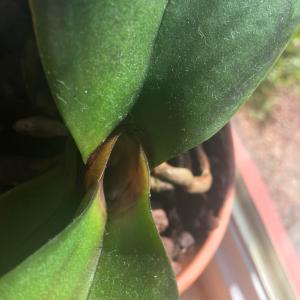
第一片叶子和小芽都掉了... 😭😭😭
还有救么……


0
0
FieryFlame:@fekorod 好滴,谢谢
fekorod:@FieryFlame 杀菌的
FieryFlame:@fekorod 涂什么药呢? 都是浸盆的,从来没浇过叶心啊……
fekorod:不一定。。伤口涂点药然后观察吧。。浇水一定别存在叶心
文章
Miss Chen
2018年05月16日

Description: This herbaceous perennial plant is about 1-2' tall, consisting of some basal leaves, branched stems with alternate leaves, and flowers. The basal leaves are up to 5" long and 5" across; they have long hairy petioles. Each basal leaf is palmately cleft into 3-5 lobes; these lobes are often divided again into smaller lobes. The alternate leaves are similar to the basal leaves, except they become smaller as they ascend the stems and their petioles are shorter. The upper leaves are more slender and divided into fewer lobes. The margins of the leaves are crenate or dentate. The upper surface of each leaf is medium to dark green and glabrous. The stems are light green, terete, and covered with long hairs; they are erect to ascending, rather than sprawling across the ground.
The upper stems terminate in loose clusters of flowers. Each flower is about 1/3" (8 mm.) across, consisting of 5-6 yellow petals, 5 light green sepals, a dense green cluster of pistils, and a ring of surrounding stamens with yellow anthers. The petals are oblong-elliptic and a little shorter than the sepals; the latter tend to hang downward while the flowers are blooming. The pedicels of the flowers are pubescent. The blooming period occurs from mid-spring to early summer and lasts about 1 month. Both sepals and petals are deciduous and they soon fall to the ground. The pistils become transformed into a dense cluster of flat-sided achenes with slender hooked beaks; this fruit is globoid in shape. Eventually, the fruit changes in color from green to nearly black. Each achene is about 2-3 mm. long. The root system consists of a cluster of fibrous roots and occasional rhizomes. Sometimes, small clonal colonies of plants are produced.

Cultivation: The preference is light to medium shade, wet to moist conditions, and soil with abundant organic material.
Range & Habitat: The native Hooked Buttercup is widely distributed in Illinois, but it is found only occasional in most areas (see Distribution Map). Habitats include damp depressions in upland woodlands, floodplain woodlands, shaded areas along streams, bottoms of rocky ravines, areas along woodland paths, swamps, forested bogs, and shady seeps. This species prefers damp woodlands and shaded wetlands.
Faunal Associations: The nectar of the flowers attracts primarily small bees. These include Cuckoo bees (Nomada spp.), Halictid bees (Augochlorella spp., Lasioglossum spp.), and Andrenid bees (Andrena spp.). Among vertebrate animals, the Wood Duck, Ruffed Grouse, and Wild Turkey feed on the seeds and foliage of Ranunculus spp. (Buttercups) in woodlands. The Eastern Chipmunk also eats the seeds of these plants. Hoofed mammalian herbivores usually avoid the consumption of buttercups because the toxic foliage contains a blistering agent that can irritate the mouth and gastrointestinal tract.
Photographic Location: Along a stream at the bottom of a rocky ravine at The Portland Arch in west-central Indiana.
Comments: This buttercup has achenes with unusually long hooked beaks; this provides its fruit with a slightly spiny appearance. While its foliage is reasonably attractive, the flowers are not very showy. Other similar buttercups include Ranunculus abortivus (Small-Flowered Buttercup) and Ranunculus pensylvanicus (Bristly Buttercup), which can be found in wet woodlands as well. Small-Flowered Buttercup has lower leaves that are kidney-shaped and lack lobes, while the palmately cleft leaves of Bristly Buttercup have more narrow lobes. The latter species also blooms later in the year (during the summer) than Hooked Buttercup. Other similar buttercups have larger flowers (at least ½" across) or their fruits (seedheads) are more elongated (ovoid or oblongoid) in shape.
The upper stems terminate in loose clusters of flowers. Each flower is about 1/3" (8 mm.) across, consisting of 5-6 yellow petals, 5 light green sepals, a dense green cluster of pistils, and a ring of surrounding stamens with yellow anthers. The petals are oblong-elliptic and a little shorter than the sepals; the latter tend to hang downward while the flowers are blooming. The pedicels of the flowers are pubescent. The blooming period occurs from mid-spring to early summer and lasts about 1 month. Both sepals and petals are deciduous and they soon fall to the ground. The pistils become transformed into a dense cluster of flat-sided achenes with slender hooked beaks; this fruit is globoid in shape. Eventually, the fruit changes in color from green to nearly black. Each achene is about 2-3 mm. long. The root system consists of a cluster of fibrous roots and occasional rhizomes. Sometimes, small clonal colonies of plants are produced.

Cultivation: The preference is light to medium shade, wet to moist conditions, and soil with abundant organic material.
Range & Habitat: The native Hooked Buttercup is widely distributed in Illinois, but it is found only occasional in most areas (see Distribution Map). Habitats include damp depressions in upland woodlands, floodplain woodlands, shaded areas along streams, bottoms of rocky ravines, areas along woodland paths, swamps, forested bogs, and shady seeps. This species prefers damp woodlands and shaded wetlands.
Faunal Associations: The nectar of the flowers attracts primarily small bees. These include Cuckoo bees (Nomada spp.), Halictid bees (Augochlorella spp., Lasioglossum spp.), and Andrenid bees (Andrena spp.). Among vertebrate animals, the Wood Duck, Ruffed Grouse, and Wild Turkey feed on the seeds and foliage of Ranunculus spp. (Buttercups) in woodlands. The Eastern Chipmunk also eats the seeds of these plants. Hoofed mammalian herbivores usually avoid the consumption of buttercups because the toxic foliage contains a blistering agent that can irritate the mouth and gastrointestinal tract.
Photographic Location: Along a stream at the bottom of a rocky ravine at The Portland Arch in west-central Indiana.
Comments: This buttercup has achenes with unusually long hooked beaks; this provides its fruit with a slightly spiny appearance. While its foliage is reasonably attractive, the flowers are not very showy. Other similar buttercups include Ranunculus abortivus (Small-Flowered Buttercup) and Ranunculus pensylvanicus (Bristly Buttercup), which can be found in wet woodlands as well. Small-Flowered Buttercup has lower leaves that are kidney-shaped and lack lobes, while the palmately cleft leaves of Bristly Buttercup have more narrow lobes. The latter species also blooms later in the year (during the summer) than Hooked Buttercup. Other similar buttercups have larger flowers (at least ½" across) or their fruits (seedheads) are more elongated (ovoid or oblongoid) in shape.
0
0


